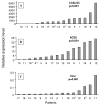Gene expression profiling in sinonasal adenocarcinoma
- PMID: 19903339
- PMCID: PMC2780459
- DOI: 10.1186/1755-8794-2-65
Gene expression profiling in sinonasal adenocarcinoma
Abstract
Background: Sinonasal adenocarcinomas are uncommon tumors which develop in the ethmoid sinus after exposure to wood dust. Although the etiology of these tumors is well defined, very little is known about their molecular basis and no diagnostic tool exists for their early detection in high-risk workers.
Methods: To identify genes involved in this disease, we performed gene expression profiling using cancer-dedicated microarrays, on nine matched samples of sinonasal adenocarcinomas and non-tumor sinusal tissue. Microarray results were validated by quantitative RT-PCR and immunohistochemistry on two additional sets of tumors.
Results: Among the genes with significant differential expression we selected LGALS4, ACS5, CLU, SRI and CCT5 for further exploration. The overexpression of LGALS4, ACS5, SRI, CCT5 and the downregulation of CLU were confirmed by quantitative RT-PCR. Immunohistochemistry was performed for LGALS4 (Galectin 4), ACS5 (Acyl-CoA synthetase) and CLU (Clusterin) proteins: LGALS4 was highly up-regulated, particularly in the most differentiated tumors, while CLU was lost in all tumors. The expression of ACS5, was more heterogeneous and no correlation was observed with the tumor type.
Conclusion: Within our microarray study in sinonasal adenocarcinoma we identified two proteins, LGALS4 and CLU, that were significantly differentially expressed in tumors compared to normal tissue. A further evaluation on a new set of tissues, including precancerous stages and low grade tumors, is necessary to evaluate the possibility of using them as diagnostic markers.
Figures



Similar articles
-
Genetic analysis of sinonasal adenocarcinoma phenotypes: distinct alterations of histogenetic significance.Mod Pathol. 2005 Mar;18(3):315-9. doi: 10.1038/modpathol.3800315. Mod Pathol. 2005. PMID: 15492756
-
Impaired expression of acyl-CoA synthetase 5 in sporadic colorectal adenocarcinomas.J Pathol. 2005 Nov;207(3):295-300. doi: 10.1002/path.1831. J Pathol. 2005. PMID: 16110457
-
Comparative genomic hybridization in primary sinonasal adenocarcinomas.Cancer. 2004 Jan 15;100(2):335-41. doi: 10.1002/cncr.11931. Cancer. 2004. PMID: 14716769
-
Sinonasal Adenocarcinoma: Update on Classification, Immunophenotype and Molecular Features.Head Neck Pathol. 2016 Mar;10(1):68-74. doi: 10.1007/s12105-016-0694-9. Epub 2016 Feb 1. Head Neck Pathol. 2016. PMID: 26830399 Free PMC article. Review.
-
Genetic and clinical aspects of wood dust related intestinal-type sinonasal adenocarcinoma: a review.Eur Arch Otorhinolaryngol. 2009 Jan;266(1):1-7. doi: 10.1007/s00405-008-0749-y. Epub 2008 Jun 17. Eur Arch Otorhinolaryngol. 2009. PMID: 18560862 Review.
Cited by
-
Galectin signatures contribute to the heterogeneity of breast cancer and provide new prognostic information and therapeutic targets.Oncotarget. 2016 Apr 5;7(14):18183-203. doi: 10.18632/oncotarget.7784. Oncotarget. 2016. PMID: 26933916 Free PMC article.
-
Sinonasal carcinoma: clinical, pathological, genetic and therapeutic advances.Nat Rev Clin Oncol. 2014 Aug;11(8):460-72. doi: 10.1038/nrclinonc.2014.97. Epub 2014 Jun 17. Nat Rev Clin Oncol. 2014. PMID: 24935016 Review.
-
Genome-scale analysis of DNA methylation in lung adenocarcinoma and integration with mRNA expression.Genome Res. 2012 Jul;22(7):1197-211. doi: 10.1101/gr.132662.111. Epub 2012 May 21. Genome Res. 2012. PMID: 22613842 Free PMC article.
-
Increase in intracellular PGE2 induces apoptosis in Bax-expressing colon cancer cell.BMC Cancer. 2011 Apr 27;11:153. doi: 10.1186/1471-2407-11-153. BMC Cancer. 2011. PMID: 21524287 Free PMC article.
-
Roles of the miR-139-5p/CCT5 axis in hepatocellular carcinoma: a bioinformatic analysis.Int J Med Sci. 2021 Aug 25;18(15):3556-3564. doi: 10.7150/ijms.57504. eCollection 2021. Int J Med Sci. 2021. PMID: 34522182 Free PMC article.
References
-
- Luce D, Leclerc A, Begin D, Demers PA, Gerin M, Orlowski E, Kogevinas M, Belli S, Bugel I, Bolm-Audorff U, Brinton LA, Comba P, Hardell L, Hayes RB, Magnani C, Merler E, Preston-Martin S, Vaughan TL, Zheng W, Boffetta P. Sinonasal cancer and occupational exposures: a pooled analysis of 12 case-control studies. Cancer Causes Control. 2002;13(2):147–157. doi: 10.1023/A:1014350004255. - DOI - PubMed
-
- Pesch B, Pierl CB, Gebel M, Gross I, Becker D, Johnen G, Rihs HP, Donhuijsen K, Lepentsiotis V, Meier M, Schulze J, Bruening T. Occupational risks for adenocarcinoma of the nasal cavity and paranasal sinuses in the German wood industry. Occup Environ Med. 2007;65(3):191–196. doi: 10.1136/oem.2007.033886. - DOI - PubMed
-
- Demers PA, Boffetta P, Kogevinas M, Blair A, Miller BA, Robinson CF, Roscoe RJ, Winter PD, Colin D, Matos E. Pooled reanalysis of cancer mortality among five cohorts of workers in wood-related industries. Scand J Work Environ Health. 1995;21(3):179–190. - PubMed
Publication types
MeSH terms
Substances
LinkOut - more resources
Full Text Sources
Other Literature Sources
Molecular Biology Databases
Research Materials
Miscellaneous

